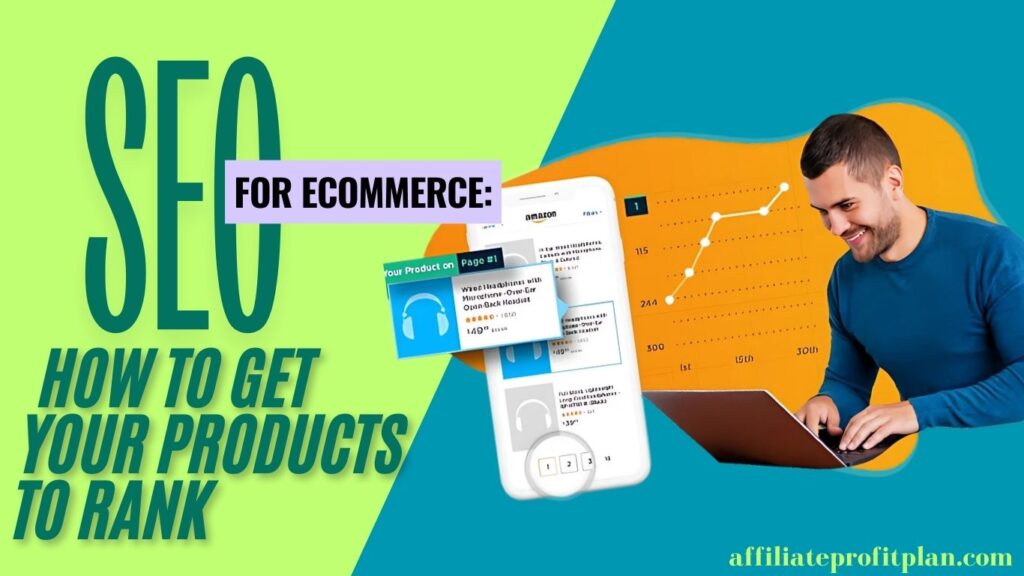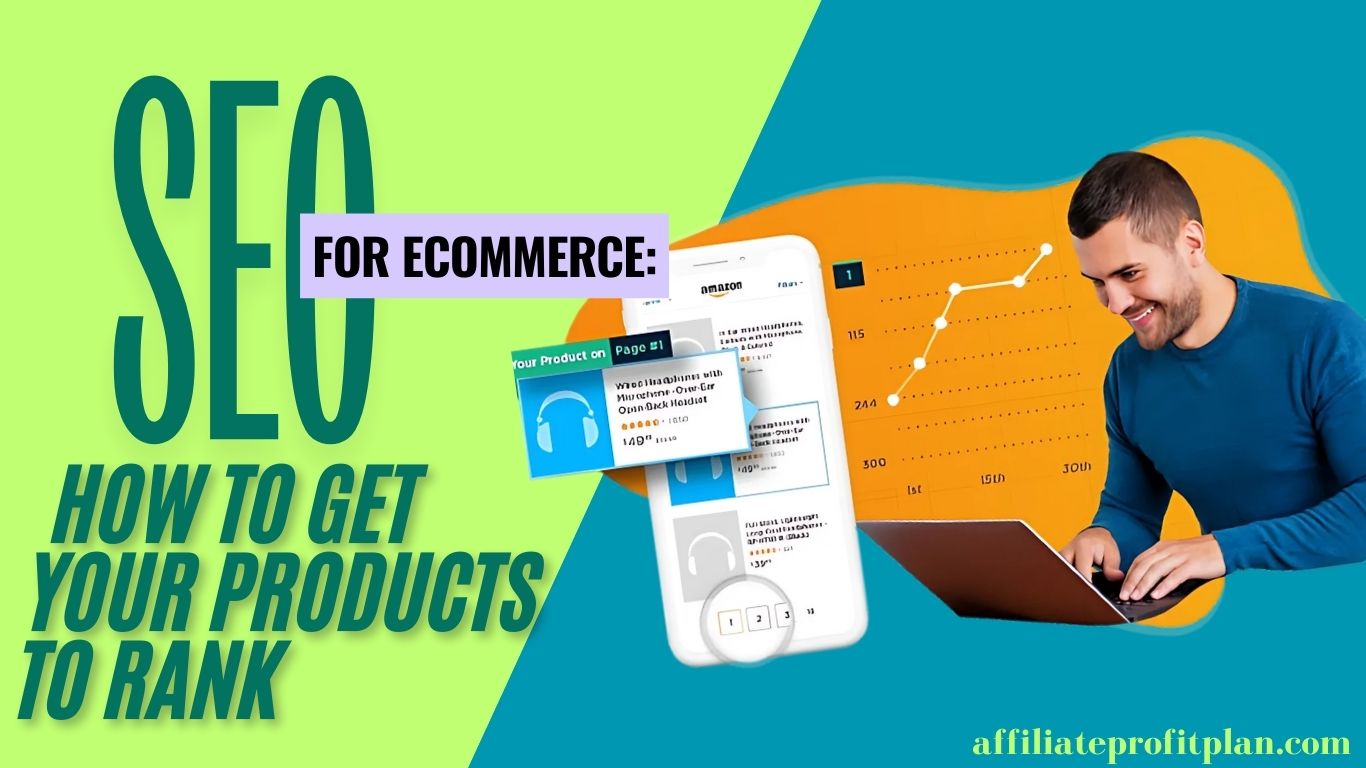Welcome to my article SEO for Ecommerce: How to Get Your Products to Rank. In the vast digital world, getting your ecommerce products to stand out is like trying to find the perfect avocado at the grocery store – it’s tricky, requires patience, and often feels like everyone else is grabbing the good ones first. But, just like mastering avocado timing, cracking the code of SEO for ecommerce can take your online store from invisible to irresistible.
In this guide, we’ll take you through the essential steps of optimizing your ecommerce store for search engines. From fine-tuning product descriptions and avoiding technical SEO blunders to leveraging content marketing and building authority, we’ve got you covered. So, buckle up—because by the time we’re done, your products will be so well-optimized, they might just go viral (okay, maybe not that viral, but you get the point).
Access My Proven Blueprint for $50-$100 Daily Income – Watch This FREE Video Now >>>

Keyword Research for Ecommerce: Finding the Golden Nuggets
When it comes to ecommerce SEO, keyword research is like treasure hunting—but instead of pirates, you’re up against Google’s algorithms and a sea of competitors. The goal? Unearth those golden keywords that will lead shoppers straight to your virtual doorstep. But not all keywords are created equal, and using the wrong ones can leave your product pages hidden deep in search results—like that one sock you lost in the laundry.
Types of Keywords You Should Be Targeting
First off, there are different types of keywords you’ll want to aim for. Just like a good mix of snacks at a party, variety is key:
Short-tail keywords (1-2 words) are broad and often highly competitive. Think “running shoes.” Sure, ranking for that would be great, but unless you’re Nike or Adidas, good luck with that! These are ideal for category pages, but they can be tough to rank for on product pages.
Long-tail keywords (3-5 words) are where the real magic happens. These are more specific and often show strong purchase intent—like “best running shoes for flat feet.” These longer phrases are your best friends because they’re less competitive and more likely to bring in ready-to-buy customers.
Product-focused keywords are the bread and butter for your actual product pages. These include specific brands, models, and details—think “Nike Air Zoom Pegasus 38 women’s running shoes.” When people search for this, they already know what they want, and you’re just there to show them the best place to buy it (your site, obviously).
Tools to Dig Up Those Keywords
Luckily, you don’t need a magnifying glass and an old map to find your keywords. Tools like Google Keyword Planner, Ahrefs, and SEMrush are like your SEO metal detectors, helping you uncover high-volume, low-competition phrases. Even Amazon’s search bar can be a goldmine—just start typing a product name, and watch how it auto-suggests popular searches. It’s like Google’s little ecommerce-obsessed cousin, and it’s fantastic for discovering what shoppers are really searching for.
And don’t forget to check out your competitors. What keywords are they ranking for? Steal a glance (ethically, of course) using tools like Ahrefs to see what terms they’re targeting—and then do it better.
Balancing Search Volume and Intent
You’ve found a keyword with 100,000 monthly searches? Congrats! But before you pop the champagne, make sure it’s relevant to your product. A high-volume keyword might drive a lot of traffic, but if it doesn’t align with what you’re selling, those visitors will bounce faster than you can say “SEO fail.”
The key here is search intent—understanding why people are searching that term. Are they just browsing, or are they ready to buy? For ecommerce, you want keywords that attract buyers, not window-shoppers. After all, it’s nice to have visitors, but it’s even better when they come with a credit card in hand.
On-Page SEO for Product Pages: The Art of Wooing Search Engines
When it comes to ecommerce, your product pages are like your store’s front window. You want them looking sharp, grabbing attention, and, most importantly, convincing people to come inside and make a purchase. But before your customers even get there, you need to make sure your product pages are wooing search engines as much as they’re charming humans. That’s where on-page SEO comes into play—it’s the digital version of dusting off your best-sellers and shining up those display cases.
Crafting Product Titles That Pack a Punch
First impressions matter, especially with Google. Your product title is the first thing search engines (and potential customers) see, so it’s got to be clear, concise, and packed with SEO goodness. Ideally, you want to sprinkle in some keywords that shoppers are actively searching for. For example, instead of a title like “Men’s Shoes” (yawn), go for something more specific like “Men’s Black Leather Running Shoes – Lightweight & Breathable”. See the difference? One is generic, the other is a keyword-loaded magnet for searchers looking for something specific.
But here’s the catch—don’t go stuffing your title with every keyword under the sun. Not only will it look awkward, but search engines will see right through it and possibly even penalize you. Be strategic, not spammy!
Now that we’ve got that killer product title, let’s talk meta descriptions. These don’t directly impact rankings, but they do affect click-through rates—and if your meta description is as bland as day-old toast, people will scroll right past you.
Think of your meta description as your elevator pitch. It’s your chance to tell potential customers why they should choose your product over the other gazillion options online. Include a primary keyword, mention a benefit (like “free shipping” or “limited-time discount”), and give them a reason to click. For example:
“Discover our men’s black leather running shoes, designed for maximum comfort and breathability. Shop now for 20% off and free shipping!”
See? Short, sweet, and to the point.
Now that we’ve got that killer product title, let’s talk meta descriptions. These don’t directly impact rankings, but they do affect click-through rates—and if your meta description is as bland as day-old toast, people will scroll right past you.
Think of your meta description as your elevator pitch. It’s your chance to tell potential customers why they should choose your product over the other gazillion options online. Include a primary keyword, mention a benefit (like “free shipping” or “limited-time discount”), and give them a reason to click. For example:
“Discover our men’s black leather running shoes, designed for maximum comfort and breathability. Shop now for 20% off and free shipping!”
See? Short, sweet, and to the point.
Product Descriptions That Sell (and Rank!)
If your product descriptions are just a couple of lines like, “Great shoes. Comfortable and stylish,” we need to have a talk. That might work for your aunt’s Facebook marketplace listing, but in the world of ecommerce SEO, your product descriptions need to do so much more.
Your descriptions should be rich in keywords, but also rich in details. Talk about the benefits, the features, how it feels, what it’s made of, and why your customer absolutely needs it. Think like a customer: what would convince you to buy this product? But here’s the trick—keep it natural. Stuffing your description with keywords like a Thanksgiving turkey won’t help. Google’s smarter than that, and so are your customers.
Plus, you want to answer any potential questions right there on the page. Not only does this improve user experience, but it also reduces returns and increases trust. A well-informed customer is a happy customer!
Alt Text for Product Images: SEO’s Secret Weapon
Your product images do a lot of heavy lifting when it comes to conversions, but they can also work behind the scenes to boost your SEO. Every image on your product page should have alt text—a short description of the image that search engines (and visually impaired users) can read.
But here’s the thing: your alt text shouldn’t just say, “shoe”. That’s a wasted opportunity! Instead, try something like, “Men’s black leather running shoe with lightweight design”. This helps search engines understand what the image represents and gives your page another SEO boost. Plus, it’s especially helpful if your images don’t load for some reason—alt text ensures people still know what they’re supposed to be seeing.
Structured Data Markup: The Invisible SEO Superhero
You’ve probably noticed that when you search for a product, sometimes results show extra information like prices, reviews, or availability—right there in the search results. That’s thanks to structured data markup (aka schema). This fancy bit of code helps search engines understand your product details and display them in a way that stands out.
By implementing Product Schema on your ecommerce site, you can make sure your listings show up with rich snippets like star ratings, stock availability, and pricing info. This not only makes your product more clickable but also gives it an extra edge in search visibility. It’s like giving your product page a shiny SEO cape!
Technical SEO for Ecommerce Websites: The Engine Under the Hood
You’ve got your product titles, descriptions, and keywords looking sharp—awesome! But none of that will matter if your ecommerce site is a clunky mess under the hood. Technical SEO is like making sure your website’s engine is running smoothly, so it doesn’t stall out right when customers hit the gas. And just like a car, if your website’s technical aspects are out of whack, it won’t get very far—no matter how shiny the paint job is (or how great your product descriptions are).
Let’s pop the hood and look at some key areas where technical SEO can make or break your ecommerce site.
Access My Proven Blueprint for $50-$100 Daily Income – Watch This FREE Video Now >>>
Speed Matters: Faster Sites Win Races
Imagine walking into a store and having to wait five minutes just for the door to open. Would you stick around? Probably not. The same goes for your website. If it’s taking longer to load than a Sunday brunch line, people are going to bounce before they even see what you’re offering.
Site speed is huge in ecommerce SEO. Not only do users hate slow sites, but so does Google. In fact, a slow site can tank your rankings faster than you can say “PageSpeed Insights.” To avoid this, optimize your images (because nobody needs a 5MB picture of a pair of socks), leverage browser caching, and minimize the number of HTTP requests. And if you’re not already doing it, compressing files and using a content delivery network (CDN) can give your site the turbo boost it needs to load quickly for users around the world.
Mobile Optimization: Tap, Scroll, and Buy
Newsflash: Most of your customers are probably browsing your site on their phones—possibly while lounging on the couch, waiting for the bus, or sneakily during a boring meeting. If your ecommerce store isn’t mobile-friendly, you’re basically telling half (or more) of your potential customers to take a hike.
Google is all about that mobile-first indexing life, meaning your site’s mobile version is what determines your ranking. So, it’s crucial that your site looks and works beautifully on mobile. That means no pinching, zooming, or accidentally tapping the wrong button because it’s crammed into a tiny corner. Responsive design is your friend here—it ensures your site adapts to different screen sizes smoothly, so customers can easily navigate, tap, and buy on any device.
Duplicate Content: The Silent SEO Killer
Ecommerce sites are notorious for duplicate content, especially if you’ve got multiple products that are similar. Google isn’t a fan of seeing the same content plastered all over your site (or worse, across multiple sites), because it can’t tell which version is the one to rank. It’s kind of like trying to decide which clone of yourself gets to go to the front of the line.
The solution? Make each product page unique—yes, even if you’re selling 20 different colors of the same t-shirt. Use canonical tags to tell Google which version of a page is the “main” one, and write unique descriptions for each product to keep things fresh. This not only helps with SEO but also makes your pages more useful and engaging for customers.
Clean, Keyword-Friendly URLs: Because “Product?id=12345” Just Won’t Cut It
Your URL structure is like your store’s address. You wouldn’t want an address that reads “Mystery Alley, 3rd Building on the Left by the Trash Cans”, right? The same goes for your URLs. Clean, descriptive URLs help both users and search engines understand what your page is about.
A URL like www.yourstore.com/womens-running-shoes/nike-air-zoom is not only easy on the eyes but also loaded with SEO-friendly keywords. Meanwhile, a URL like www.yourstore.com/product?id=12345 is a lost opportunity. Keep it simple, keep it descriptive, and throw in those relevant keywords where they naturally fit.
Site Architecture and Internal Linking: Show Google the Way
A well-structured ecommerce site is like a well-organized warehouse. Customers (and search engines) need to be able to find what they’re looking for without getting lost in a maze of random aisles. Site architecture is all about creating a logical, easy-to-navigate hierarchy that guides both users and search engines through your site.
Start with broad categories (e.g., “Men’s Shoes”) and then branch out into more specific subcategories (e.g., “Running Shoes” > “Nike Running Shoes”). This helps both search engines understand your site’s layout and users quickly find what they’re looking for.
Don’t forget about internal linking! It’s like creating a trail of breadcrumbs for Google’s crawlers. Linking from your category pages to your product pages—and even between related products—helps distribute link equity throughout your site. Plus, it gives users more opportunities to explore (and buy) while boosting your SEO at the same time.
Secure Your Site: HTTPS is a Must
If your ecommerce site still doesn’t have that shiny little lock icon in the browser (aka HTTPS), it’s time for an upgrade. Not only does HTTPS encrypt sensitive data (which is super important for ecommerce), but Google also considers it a ranking factor. In short, an insecure site is bad for SEO and even worse for customer trust.
Getting an SSL certificate is an easy win for both security and rankings. Customers will feel safer entering their payment info, and search engines will give you a boost for taking security seriously. It’s a win-win!
Technical SEO might not be as flashy as writing product descriptions or designing a beautiful homepage, but it’s the backbone that keeps your ecommerce site running smoothly—and ranking higher. By optimizing speed, mobile usability, URL structure, and site architecture, you’re not just making Google happy—you’re creating a seamless experience for customers that drives sales. And let’s be honest, nothing says “SEO success” like a well-oiled, high-converting website.
Content Marketing for Ecommerce SEO: More Than Just Product Pages
If you think your ecommerce SEO strategy stops at optimizing product pages, it’s time to think bigger. Like, way bigger. Content marketing is the secret weapon that not only boosts your SEO but also builds trust with your audience, attracts new visitors, and keeps customers coming back for more. Think of it as the window dressing around your storefront—it adds personality, gives customers useful information, and creates a reason for them to stick around. Plus, it tells Google, “Hey, I’m more than just a bunch of product listings. I’ve got valuable info too!”
Let’s dive into how you can use content marketing to give your ecommerce SEO a serious glow-up.
Product Guides and Blogs: The Bread and Butter of Content Marketing
Sure, you’ve got killer product pages, but what if I told you a blog could bring in even more traffic? That’s right—blogging isn’t just for foodies and travel junkies. It’s a powerful tool for ecommerce stores to rank for informational keywords that might not directly scream “buy now” but attract the right audience.
For example, if you sell running shoes, a blog post titled “How to Choose the Best Running Shoes for Flat Feet” not only helps people find your site but also provides them with useful, trust-building information. And when they’re ready to buy? You guessed it—they’re already on your website, just a click away from your product pages.
Then there are product guides—these are gold for SEO. Think of them as the ultimate sidekick to your product listings. Writing in-depth buying guides, “how-to” posts, or comparison articles (e.g., “Nike vs. Adidas: Which Running Shoe is Best for You?”) helps answer common customer questions while positioning your products as the perfect solution. And guess what? Google loves this kind of content because it’s helpful, informative, and matches user intent. In return, you’ll see higher rankings and more qualified traffic.
User-Generated Content (UGC): The Gift That Keeps On Giving
Let’s face it—people trust other people more than they trust brands. Enter user-generated content (UGC). We’re talking customer reviews, photos, videos, and testimonials that show real-life buyers loving your products. Not only does UGC build social proof, but it also gives your ecommerce site fresh, relevant content that search engines adore.
Here’s the best part: UGC is essentially free content, and it often contains those long-tail keywords you might not have thought of. For instance, a customer might leave a review saying, “These waterproof hiking boots survived a whole week of rain in Scotland!”—boom, you’ve just got a new long-tail keyword without lifting a finger. Encouraging reviews and photos not only boosts trust but also keeps your content fresh and your rankings healthy.
Video Content: Because Google Loves a Good Visual
If a picture is worth a thousand words, then video content is worth a million views—especially when it comes to SEO. Google’s algorithms are increasingly prioritizing video-rich content, and ecommerce sites that hop on this trend are reaping the rewards.
Think of creating product demo videos, tutorials, or unboxings that show your product in action. Not only do these videos give potential customers more confidence in what they’re buying, but they also provide extra SEO juice. You can optimize your video titles, descriptions, and even transcriptions with targeted keywords to help them rank better on both Google and YouTube (because let’s not forget, YouTube is the world’s second-largest search engine).
Pro tip: Embed videos on your product pages to boost time-on-page metrics (which search engines love), and use those video descriptions to target additional keywords. Double the impact, double the fun.
Infographics and Visual Content: Snackable and Shareable
We live in a world of scrolling. Attention spans are short, but that’s where infographics come in. These bite-sized, highly visual pieces of content are perfect for delivering information quickly and engagingly. And because people love to share a good infographic, they can help build backlinks and drive traffic.
For example, if you sell eco-friendly products, an infographic on “The Environmental Impact of Fast Fashion vs. Sustainable Brands” could not only educate your audience but also encourage shares on social media, building backlinks to your site. These backlinks are like SEO rocket fuel—they show Google your site is trustworthy and authoritative, boosting your rankings.
The Power of FAQ Pages: Content That Solves Problems
Never underestimate the SEO power of a well-crafted FAQ page. Customers are always full of questions—what sizes do you carry, how long does shipping take, is this product vegan? Instead of letting those questions pile up in your inbox, why not turn them into an SEO opportunity?
By answering common customer queries with keyword-rich, informative answers, you can create content that hits multiple birds with one stone. Not only are you improving user experience by providing clear answers, but you’re also optimizing for voice search and featured snippets (those quick-answer boxes that Google loves). If a customer asks Google, “Is this jacket waterproof?” and your FAQ page has the answer, guess who’s getting featured at the top of the search results? (Hint: it’s you.)
Leveraging Social Media for Content Amplification
Your content marketing efforts don’t have to live on your website alone. Social media is a powerful tool to amplify your SEO content. Every blog post, product guide, or infographic you create can be repurposed and shared across platforms like Instagram, Pinterest, or Facebook.
While social signals aren’t a direct ranking factor, sharing your content increases traffic to your site, which does impact SEO. Plus, the more eyes on your content, the greater the chance of earning backlinks, building brand authority, and boosting engagement. Just make sure to include SEO-friendly keywords in your social posts to make them easily discoverable.
Off-Page SEO: Building Authority and Backlinks—Your Website’s Popularity Contest
If on-page SEO is like getting your house in order, off-page SEO is throwing a party and inviting everyone to come see how awesome it is. But instead of getting compliments on your new furniture, you’re looking for something far more valuable: backlinks. Yes, backlinks are the lifeblood of off-page SEO, and the more quality links pointing to your ecommerce site, the more Google thinks, “Hey, this site must be legit.” It’s like winning a popularity contest, but instead of a shiny trophy, you get higher rankings and more organic traffic.
But there’s a catch: you can’t just ask for backlinks (well, you can, but there’s more to it than that). To build authority and earn those precious links, you need a strategy. So let’s break down how to get your ecommerce site the backlink love it deserves.
Quality Over Quantity: Not All Backlinks Are Created Equal
Before you start sending out spammy emails begging for links (please don’t), let’s talk about link quality. Getting backlinks isn’t just about collecting as many as you can like Pokémon cards. You need high-quality backlinks from authoritative, relevant sites in your industry. In Google’s eyes, a link from a reputable site like Forbes or TechCrunch is worth a hundred times more than a link from your cousin’s food blog.
How do you determine if a site is backlink-worthy? Look for websites with high domain authority (DA) and strong reputations. In the world of SEO, authority is everything, and getting a link from a high-authority site is like getting a recommendation from a celebrity. Google takes notice, and so does your search ranking.
Guest Blogging: Sharing is Caring
One of the most popular (and effective) ways to build backlinks is through guest blogging. It’s like being invited to someone else’s party and charming their friends (read: audience) while sneaking a backlink to your site into the conversation. When done right, guest posts let you share your expertise on other sites, provide valuable content to their readers, and sneak in a link back to your ecommerce store.
The key to guest blogging is to offer real value. Reach out to sites that are relevant to your industry, pitch them blog ideas that would resonate with their readers, and make sure your posts are packed with useful information. Nobody likes a post that’s just a thinly veiled excuse to drop a link. The more genuine and helpful your content, the more likely you’ll earn those coveted backlinks.
Pro tip: Always check the linking site’s authority before pitching guest blogs. Writing for a low-quality site won’t help you rank higher, and it could even hurt your SEO in the long run.
Influencer Marketing: Backlinks with Star Power
In today’s social media-driven world, influencers are like the rockstars of the digital age. And guess what? Their websites and social media channels can give your SEO a serious boost. When an influencer in your niche links to your ecommerce site or mentions your products, it’s not just a win for your brand awareness—it’s a backlink with serious power.
Working with influencers can be as simple as sending them your products for a review or collaborating on a blog post. When they link back to your site or share your product with their audience, Google sees this as a sign of trust. Just be sure to choose influencers who are relevant to your industry. A fitness influencer linking to your sportswear line? Perfect. A makeup influencer linking to your kitchen gadgets? Not so much.
And remember, while social media links don’t directly boost SEO, the increased traffic they bring can lead to more shares, more backlinks, and, ultimately, better search rankings.
Broken Link Building: Turning 404s Into Opportunities
Here’s a sneaky yet highly effective way to build backlinks: broken link building. It’s like playing the role of an internet janitor—cleaning up messes and getting rewarded for your hard work. The idea is simple: find broken links on relevant sites (those 404 error pages everyone hates), then swoop in with a suggestion to replace the broken link with one to your own relevant content.
For example, let’s say you find a blog post about “10 Best Running Shoes for Flat Feet” on a popular fitness site, but one of the links leads to a dead page. You could reach out to the site owner and say, “Hey, I noticed one of your links is broken. I’ve got a great guide on the best running shoes that would be a perfect replacement!” Not only are you helping them out, but you’re also scoring yourself a sweet backlink.
Tools like Ahrefs or Broken Link Checker can help you find these broken links. And trust me, there are plenty of them out there just waiting to be fixed.
Earn Links Naturally with Awesome Content
The holy grail of backlink strategies is earning links naturally. In other words, creating such amazing content that people can’t help but link to it. Easier said than done, right? But when you nail it, natural backlinks are like SEO gold.
What type of content gets backlinks? Original research, infographics, ultimate guides, and case studies are all great candidates. People love sharing and linking to data-driven content or helpful, comprehensive resources. If your ecommerce site sells hiking gear, for example, a well-researched post like “The Complete Guide to Preparing for a Multi-Day Hike” can attract tons of attention—and backlinks—from other outdoor blogs, forums, and news sites.
The best part? When you create high-quality, valuable content, the backlinks come to you without you having to chase them down. It’s like being so cool that everyone just wants to invite you to the party.
Press Coverage and PR: SEO’s Secret Weapon
Getting press coverage from reputable sites is like hitting the SEO jackpot. Not only does it give your ecommerce store massive exposure, but it also provides backlinks from news outlets and authority sites that can skyrocket your rankings. Whether you’ve launched a new product, are running a unique promotion, or have an interesting brand story, reaching out to journalists and industry publications can get your business featured in the news—and those backlinks from authoritative news sites can make a big difference.
Don’t be shy about using HARO (Help a Reporter Out), a platform where journalists seek experts for their stories. If you can offer your insight, you might land a mention and a backlink in an upcoming article. Talk about a win-win!
In the world of ecommerce SEO, off-page SEO is like building your online reputation—and backlinks are the currency that shows Google you’re the real deal. By focusing on quality over quantity, leveraging guest blogging, working with influencers, fixing broken links, and earning natural mentions with stellar content, you can grow your authority and climb the rankings. It’s not about being the loudest voice in the room—it’ about getting the right people (and websites) to vouch for you.
Conclusion: Ready, Set, Rank!
Congratulations—you’ve just unlocked the ultimate toolkit for ecommerce SEO success! From mastering keyword research and polishing your product pages, to fine-tuning your technical SEO and crafting content that converts, you’re now armed with everything you need to climb those search engine rankings like a pro. But remember, SEO isn’t a one-and-done deal—it’s more like a marathon than a sprint. Google’s algorithms are always evolving, so keeping up with SEO trends and continuously optimizing your site is key to staying ahead of the competition.
Access My Proven Blueprint for $50-$100 Daily Income – Watch This FREE Video Now >>>
Think of SEO as a long-term investment in your online store’s future. The effort you put in today may not pay off immediately, but when the traffic starts rolling in and those sales numbers start ticking upwards, you’ll be glad you did the hard work.
As you optimize, don’t forget that your primary goal is to create a seamless experience for your customers. Because at the end of the day, great SEO isn’t just about pleasing Google—it’s about pleasing your users. A fast, easy-to-navigate site with helpful content, clear product pages, and a strong sense of authority is not only going to rank higher—it’s going to turn curious visitors into loyal customers. And let’s face it, happy customers are the real SEO success metric, right?
So, whether you’re tweaking your site’s load speed or brainstorming your next blog post idea, remember: every little improvement gets you one step closer to the top. Keep at it, stay patient, and before you know it, your ecommerce store will be standing proudly at the top of search results, basking in the glow of all those sweet, sweet organic clicks. Now go get your site ranking, and may the SEO force be with you!
Thanks a lot for reading my article on “SEO for Ecommerce: How to Get Your Products to Rank“ till the end. Hope you’ve helped. See you with another article.










